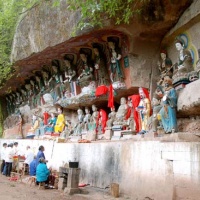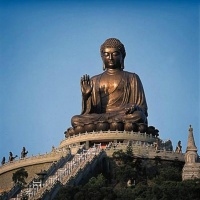- Home Page
- Fact Tours
Our sample tour itineraries of China and China travel packages are sorted by theme and available at competitive prices, you can browse what tours are right for you for your trip to China.
Popular China Tour Packages

Custom Tour Packages to China and Ask Our Experts for Free Enquiry !
- Coach Tours
- Destinations
Beijing, the capital of China. Its art treasures and universities have long made it a center of culture and art in China.
Beijing Top Attractions
Beijing City Tours
Best China Tours with Beijing
Shanghai, the cultural and economic center of East Asia. It renowned for its historical landmarks, the extensive and growing skyline.
Shanghai Top Attractions
Shanghai City Tours
Best China Tours with Shanghai
Xi'an, having held the position under several of the most important dynasties. It is the top destination to explore the facts of Chinese history.
Xi'an Top Attractions
Xi'an City Tours
Best China Tours with Xi'an
Huangshan boasts its culture, beautiful rivers, villages and mountains. It's home to 2 UNESCO World Heritage Sites and the Mecca of photographers.
Huangshan Top Attractions
Huangshan City Tours
Best China Tours with Huangshan
Sichuan is the cradle of the Shu culture, panda, mahjong, teahouse and spicy food. The province ranks first in China by number of UNESCO World Heritage Sites. It is called "the Heaven of Abundance".
Sichuan Top Attractions
Sichuan Tour Packages
Best China Tours with Sichuan
Yunnan, literally means the south of colorful clouds, due to its beautiful landscapes, mild climate and diverse ethnic cultures and traditions, is one of China's major tourist destinations.
Yunnan Top Attractions
Tibet, the nearest land to the sky, is known for its breathtaking landscape, splendid culture, art, buildings, and mysterious religions.
Tibet Top Attractions
Tibet Tour Packages
Best China Tours with Tibet
Explore the lost civilizations by riding a camel! Travel across the Gobi and the desert, and over the high mountains. Our Silk Road tours including different sections of the Silk Road in China.
Silk Road Top Attractions
Silk Road Tour Packages
Best China Tours with Silk Road
Guilin, an internationally-known historical and cultural city, has long been renowned for its unique karst scenery. Its vicinities are the paradise of hiking, caving, rafting, biking and countryside exploring.
Guilin Top Attractions
- China Facts
- China Hotels
- Travel Photos
Religions and Beliefs
Chinese Buddhism
Buddhism (Fo Jiao)
Buddhism was founded in India by Siddhartha Garutama (563-483 BC) of the Sakyas. Siddhartha was his given name, Gautama his surname and Sakya the name of the clan to which his family belonged.
 The cornerstone of Buddhist philosophy is the view that all life is suffering. Everyone is subject to the traumas of birth, sickness, decrepitude and death; to what they most dread (an incurable disease or an ineradicable personal weakness); and to separation from what they love.
The cornerstone of Buddhist philosophy is the view that all life is suffering. Everyone is subject to the traumas of birth, sickness, decrepitude and death; to what they most dread (an incurable disease or an ineradicable personal weakness); and to separation from what they love.
The cause of suffering is desire - specifically the desires of the body and the desire for personally fulfillments. Happiness can only be achieved if these desires are overcome, and this requires following the 'eightfold path'. By following this path the Buddhist aims to attain nirvana. Volumes have been written in attempts to define nirvana; the suttas ( discourses of the Buddha) simply say that it's a state of complete freedom from greed, anger, ignorance and the various other 'fetters' of existence.
Buddhism developed in China from the 3rd to 6th centuries AD. In the middle of the 1st century AD the religion gained the interest of the Han emperor Ming. He sent a mission to the west, which returned in 67 AD with Buddhist scriptures, tow Indian moons and images of the Buddha.
Centuries later, other Chinese moons like Xuan Zang Journeyed to Indian and returned with Buddhist scriptures which were then translated from the original Sanskrit. Buddhist monasteries and temples sprang up everywhere in China, and played a similar role to the churches in monasteries of medieval Europe - functioning as guesthouses, hospitals and orphanages for travelers and refuges. Gifts from the faithful allowed them to amass considerable wealth and set up money-leading enterprises and pawnshops. These pawnshops functioned as unofficial banks for the poor right up to the mid-20th century.
The Buddha wrote nothing; the Buddhist writings that have come down to us date from about 150 years after his death. By the time these texts came out, divisions had already appeared within Buddhism. Some writers tried to emphasize the Buddha's break with Hinduism, while others tried to minimize it. At some stage Buddhism split into two major schools: Theravada and Mahayana.
The Theravada, or 'doctrine of the elders' school (also called Hinayana or 'little vehicle' by non-Theravadins0 holds that the path to nirvana is an individual pursuit. It centers on monks and nuns who make the search for nirvana a full-time profession. This school maintains that people are alone in the world and must tread the path to nirvana on their own; Buddha can only show the way. The Theravada school is the Buddhism of Sri Lanka, Myanmar, Thailand, Laos and Cambodia.
 The Mahayana, or 'big vehicle', school holds that since all existence is one, the fate of the individual is linked to the fate of others. The Buddha did not just point the way and float off into his own nirvana, but continues to offers spiritual help to others seeking nirvana. The Mahayana school is the Buddhism of Vietnam, Japan, Tibet, Korea, Mongolia and China.
The Mahayana, or 'big vehicle', school holds that since all existence is one, the fate of the individual is linked to the fate of others. The Buddha did not just point the way and float off into his own nirvana, but continues to offers spiritual help to others seeking nirvana. The Mahayana school is the Buddhism of Vietnam, Japan, Tibet, Korea, Mongolia and China.
Mahayana Buddhism is replete with innumerable heavens, hells and descriptions of nirvana. Prayers are addressed to the Buddha and combined with elaborate ritual. There are deities and bodhisattvas - a rank of supernatural beings in their last incarnation before nirvana. Temples are filled with images such as the future Buddha, Maitreya (often portrayed as fat and happy over his coming promotion) and Amitabha (a savior who rewards the faithful with admission to Christian - like paradise).
In Tibet and areas of Gansu, Sichuan and Yunnan, a unique form of the Mahayana school is practiced: Tantirc or Lamaist Buddhism (lama jiao). Tantiric Buddhism, often called Vajrayana or 'thunderbolt vehicle' by its followers, has been practiced since the early 7th century AD and is heavily influenced by Tibet's pre-Buddhist Bon Religion, which relied on priests or shamans to placate spirits, gods and demons.
Generally speaking, it is much more mystical than other forms of Buddhism, relying heavily on mudras(ritual postures), mantras(sacred speech), yantras (sacred art) and secret initiation rites, Priests called lamas are believed to be reincarnations or highly evolved beings; the Dalai Lama is the supreme patriarch of Tibetan Buddhism.
Questions & Comments
Home | About Us | Partnerships | Terms & Conditions | Privacy & Security | Payment Guide | Resource Links| Sitemap
Email: contact@chinafacttours.com, Tel: +86-773-3810160, Fax: (+86) 773-3810333
Copyright © 2008-2022 China Fact Tours. All rights reserved
![]()









